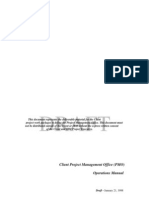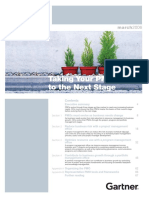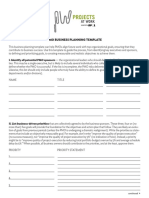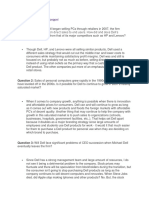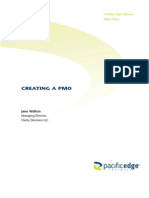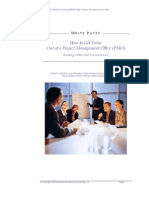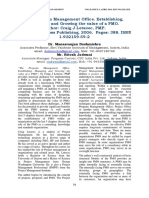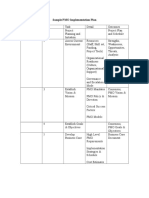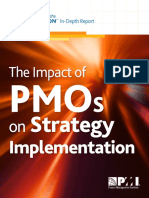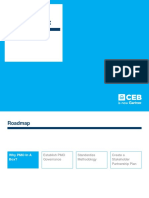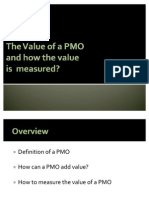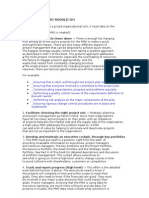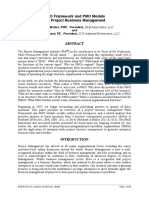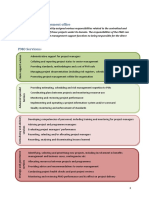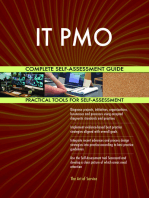0 ratings0% found this document useful (0 votes)
226 viewsEGov Conf - PMO Workshop v3
EGov Conf - PMO Workshop v3
Uploaded by
fayez_vipThe document discusses project, program, and portfolio management. It provides definitions and overviews of key concepts including the project life cycle, management disciplines, and the PMBOK framework. The document also discusses the purpose and models of a Program Management Office (PMO) and how a PMO can help an organization.
Copyright:
© All Rights Reserved
Available Formats
Download as PDF, TXT or read online from Scribd
EGov Conf - PMO Workshop v3
EGov Conf - PMO Workshop v3
Uploaded by
fayez_vip0 ratings0% found this document useful (0 votes)
226 views53 pagesThe document discusses project, program, and portfolio management. It provides definitions and overviews of key concepts including the project life cycle, management disciplines, and the PMBOK framework. The document also discusses the purpose and models of a Program Management Office (PMO) and how a PMO can help an organization.
Original Description:
EGov Conf - PMO Workshop v3
Copyright
© © All Rights Reserved
Available Formats
PDF, TXT or read online from Scribd
Share this document
Did you find this document useful?
Is this content inappropriate?
The document discusses project, program, and portfolio management. It provides definitions and overviews of key concepts including the project life cycle, management disciplines, and the PMBOK framework. The document also discusses the purpose and models of a Program Management Office (PMO) and how a PMO can help an organization.
Copyright:
© All Rights Reserved
Available Formats
Download as PDF, TXT or read online from Scribd
Download as pdf or txt
0 ratings0% found this document useful (0 votes)
226 views53 pagesEGov Conf - PMO Workshop v3
EGov Conf - PMO Workshop v3
Uploaded by
fayez_vipThe document discusses project, program, and portfolio management. It provides definitions and overviews of key concepts including the project life cycle, management disciplines, and the PMBOK framework. The document also discusses the purpose and models of a Program Management Office (PMO) and how a PMO can help an organization.
Copyright:
© All Rights Reserved
Available Formats
Download as PDF, TXT or read online from Scribd
Download as pdf or txt
You are on page 1of 53
At a glance
Powered by AI
The key takeaways are an overview of project, program and portfolio management concepts as well as a case study on implementing a project management office (PMO) called YesMethod© at Yesser.
Some key definitions discussed in the introduction include the differences between a project, program and portfolio as well as the project life cycle.
The three main management disciplines discussed are project management, program management and portfolio management.
Project & Program Management
Suhail M. Al-Almaee - Director Strategic Planning and Supporting Initiatives
Muhannad H. Tayem - Director Consulting - Deloitte
Mounes R. Shadid - Project Management Specialist
salmaee@yesser.gov.sa
mtayem@DELOITTE.COM
mshadid@yesser.gov.sa
pmo@yesser.gov.sa
Opening & Objectives
Suhail M. Al-Almaee - Director Strategic Planning and Supporting Initiatives
salmaee@yesser.gov.sa
mshadid@yesser.gov.sa
pmo@yesser.gov.sa
Agenda
S. # From To Topic Presenter
1 01:00 01:10 Opening & Objectives Suhail Al Almaee
2 01:10 01:25 Introduction Muhannad Tayem
3 01:25 01:50 PMO Overview Muhannad Tayem
4 01:50 02:10 Portfolio Management Overview Muhannad Tayem
5 02:10 02:25 Q&A
6 02:25 02:40 Break
7 02:40 03:10 YesMethod Yessers Case
Mounes Shadid &
Suhail Al Almaee
8 03:10 03:25 Q&A
9 03:25 03:30 Closing Suhail Al Almaee
Objectives
Build awareness about the Project/Program Management and PMO
Communicate key success factors and challenges
Present YesMethod as a case for applying Project/Program Management
standards
Listen to your experience in relation to the subject
Introduction
Muhannad H. Tayem - Director Consulting Deloitte
mtayem@DELOITTE.COM
Introduction Key Definitions
Project
B
Project
C
Project
D
Project
A
Program
1
Program
2
Portfolio
Project
E
Program
Project
Portfolio
A Project is a temporary endeavor undertaken to create a product,
service or
result
to obtain an objective (deliverable) and terminate.
A Portfolio is Overall collection of the
organizations grouping of high-level initiatives
and their respective projects/programs.
A Program is a set of projects that
have a common objective and
interdependencies that need to be
managed. A set of interrelated and
inter-dependent projects .
Introduction The Project Life Cycle
Analyze Analyze
Portfolio Portfolio
Initiating
Prioritize Prioritize
Planning
Monitoring &
Controlling
Executing
Closing
Idea
Benefits
Harvesting
Business
Case
Monitoring &
Controlling spans the
life of a project and is
used to actively
manage and
communicate its
progress.
The project life cycle
is the business
process for
requesting, selecting,
developing and
implementing
projects to achieve
organizational
strategies and
objectives.
Introduction Management Disciplines
Project Management is concerned with the definition and delivery of specific
work streams within an overall program framework.
Program Management is
the application of
consistent tools and
methods in order to deliver
and co-ordinate related
projects and Programs.
Portfolio Management is the management process of translating strategy or
policy into actionable Programs that can be developed in a portfolio of
Programs.
Introduction The Management Framework
Portfolio Management has primary focus on:
Translating business strategy into manageable initiatives
Managing and tracking the portfolio of initiatives
Regular checkpoints at which the benefits and results of
the initiatives are reviewed to understand their impact
Portfolio
Management
Program
Management
Project
Management
Program Management focuses amongst others:
Creation and management of key Program
deliverables including business case and others
Identify, manage and address interdependencies
between projects
Program benefits tracking and realization
Portfolio
Management
Program
Management
Project
Management
Project Management has primary focus on:
Execution and delivery of planned project deliverables
and milestones
Management of project schedules, budget, issues,
risks, and change requests using defined tools
Escalation of project issues, change requests and
risks, where necessary
Portfolio
Management
Program
Management
Project
Management
Introduction PMBOK
The Project Management Body Of Knowledge (PMBOK) is a collection
of processes and knowledge areas generally accepted as best practice
within the project management discipline. (Published by PMI)
1. Initiating
2. Planning
3. Executing
4. Monitoring & Controlling
5. Closing
Process Groups
1. Project Integration Management
2. Project Scope Management
3. Project Time Management
4. Project Cost Management
5. Project Quality Management
6. Project Human Resource Management
7. Project Communications Management
8. Project Risk Management
9. Project Procurement Management
Knowledge Areas
Inputs
Tools &
Techniques
Outputs
Documents
Plans
Designs
Mechanisms
applied to
inputs
Documents
Products
PMO
Muhannad H. Tayem - Director Consulting Deloitte
PMO What Do Organizations Need?
Given our longer term vision, what are the
opportunities today?
How do we translate our strategy into targets for all
our stakeholders to clearly understand?
How realistic are the targets and vision?
What are the
right things
to do?
Will the projects underway let us achieve our
strategic objectives?
What is the correct balance between
growth/innovation projects and
productivity/maintenance projects?
Are we doing
enough of the
right
things?
What is the appropriate governance structure and
risk management approach to facilitate a fast
response to issues and opportunities?
How do you get the message across to change
peoples behavior?
How are benefits being tracked?
Are we doing
the right
things
right"?
Portfolio
Management
PMO
PMO What is PMO?
An organization dedicated to improve the practice and results of project
management.
Provides an opportunity for project managers to develop professionally more
quickly than most could ever hope, if they were working isolated from one
another.
An organizational entity
created to assist project
managers in achieving
project goals.
A group of people with a
mission to support project
managers in the
successful launch,
implementation, and
completion of projects.
PMO
PMO The Value of PMO
Inconsistent planning and scheduling
approaches
Deliverable / technology focus
Little integration across projects
Lack of business management leadership
and visibility
Unjustified projects
Inability to present accurate overall
picture to management
Impact on market and shareholder
perceptions
Strategy
Typical Environment Before
P
r
o
j
e
c
t
M
a
n
a
g
e
m
e
n
t
Project
Office
P
o
r
t
f
o
l
i
o
M
a
n
a
g
e
m
e
n
t
p
r
o
g
r
a
m
M
a
n
a
g
e
m
e
n
t
Project
Office
Project
Office
Project
Office
Operational efficiencies through
consistent processes for Monitoring,
Controlling & Reporting
Proactive management , planning and
steering
Delivery oriented to business milestones
Focus on content rich initiatives rather
than process
Coaching and mentoring for project /
program managers
Minimized gaps in strategic business
alignment
Typical PMO environment
Coordination
Delivery
Strategy
PMO
PMO
EPMO
Project
Office
Project
Office
Project
Office
Project
Office
PMO How Can PMO Help You?
Leadership visibility for your project via central reporting function.
issues and risks register facilitates more pro-active management
Avoids project team managers dealing with project interdependencies which cause delay
and misunderstanding
Addresses the information gap that arises between project work and the enterprise, by
providing the link between the two
Common methodology, tools and templates to assist but still leave the Project Managers
with the ultimate accountability to deliver their project
Provides baseline data as a project delivery target against which a project can be
measured
Visibility and success will create a more project based organization and enable
transformation through programs of change
PMO PMO Models
A key success factor for Program Management Offices is to select the
right organization model that fits both the organizations culture and
needs.
Increase Level
of Operational
Excellence
Increase Level of
Business Unit
Responsibility
The PMO has an
advisory role and
provides counseling,
training and tools to
business units
project managers.
Model
Mandate
Support
The PMO provides
active support to
project managers.
Projects are delivered
according to the
project management
standards established.
Control
The PMO is
responsible for project
delivery. The PMO
provides trained
project managers to
business units
sponsors. Projects are
delivered according to
the project
management
standards established.
Lead
PMO Where Does it Fit? (1/2)
Depending on the type of projects under
the PMO, PMO can be under specific unit
to serve specific units projects or at the
level of the organization to server all
units in the organization
The PMO normally consists of a full time,
dedicated team, reporting to a PMO
Head, supporting the program/projects
managers
The structure within the PMO is different
based on the PMO type. The PMO can
also deploy envoys into large individual
work streams to provide program
management support direct and full time
to the work streams.
CEO
Shared
Services
IT
IT PMO
Admin
Core
Business
EPMO
Legal & Risk
It is not recommended to
have more then one PMO
in the organization. In
addition ,the more PMO is
empowered, the more
successful it is.
PMO Where Does it Fit? (2/2)
Generate Ideas Value
proposition
Detailed
Business Case
Execute
Strategic Enterprise
Programmes /
Projects
Steercom
S
i
t
e
L
e
v
e
l
Generate Ideas Value
proposition
Detailed
Business
Case
Execute
Projects
Steercom
Submit to Strategic PMO for
prioritisation & approval
S
t
r
a
t
e
g
i
c
L
e
v
e
l
Approve or decline value propositions and
business cases based on strategic alignment,
fit and prioritisation (based on risk and value)
Set standards and guidelines for running
projects
Provide governance structure during project
execution and approval
Coordinating and encouraging transferring of
best practices
Facilitates consolidated reporting of progress
towards meeting strategic objectives
At the Decentralised level the following will occur:
Detailed business case development by line
Site Steercom / management approval of
value propositions and business cases for
submission to Strategic PMO for prioritisation
and further approval
Execution of approved projects
Reporting of progress to Strategic PMO
Strategic PMO
Decentralised PMO
PMO Typical Approach to Build a PMO
Rollout
Defines
Role and
Staff
Needs
Pilot
PMO
Staff
PMO
Define PMO
Goals &
Governance
Design /Build
PMO
Processes &
Tools
1
2
3
4
5
6
Measure
and
Update
7
PMO Typical PMO Tool Functionality
Ability to manage and
coordinate all changes to the
program/projects schedule,
cost and scope
Can proactively identify
and manage risks and
issues that may impact
achieving the program
objectives
Way to plan,
balance and
schedule
resources for
effective
resource
allocation
Get a single view for
enterprise Portfolio,
Program, and Project
planning and execution
An integrated
framework to execute
programs and projects
to deliver associated
benefits
On-demand reporting and
pre-built analytics for
measuring program
performance
PMO Capability Maturity Model
PMO Maturity Model
Does the organization
recognize projects and run
them differently from its
ongoing business?
(Projects may be run
informally with no
standard process or
tracking system.)
Does the organization
ensure that each project is
run with its own processes
and procedures to a
minimum specified
standard? (There may be
limited consistency or co-
ordination between
projects)
Does the organization have
its own centrally controlled
project processes, and can
individual projects flex
within these processes to
suit the particular project?
Does the organization
retain specific metrics on
its project management
performance and run a
quality management
organization to better
predict future
performance?
Does the organization run
continuous process
improvement with
proactive problem and
technology management
for projects in order to
improve its ability to
depict performance over
time and optimize?
P
r
o
j
e
c
t
1
Initial
Process
2
Repeatable
Process
3
Defined
Process
4
Managed
Process
5
Optimized
Process
Does the organization
recognize programs and
run them differently to
projects? (Programs may
be run informally with no
standard process or
tracking system.)
Does the organization
ensure that each program
is run with its own
processes and procedures
to a minimum specified
standard? (There may be
limited consistency or co-
ordination between
programs)
Does the organization have
its own centrally controlled
program processes and
can individual programs
flex within these processes
to suit the particular
program?
Does the organization
obtain and retain specific
measurements on its
program management
performance and run a
quality management
organization to better
predict future program
outcomes?
Does the organization run
continuous process
improvement with
proactive problem and
technology management
for programs in order to
improve its ability to
depict performance over
time & optimize?
P
r
o
g
r
a
m
Does the organization's
Board recognize programs
and projects and run an
informal list of its
investments in programs
and projects?
Does the organization
ensure that each program
and/or project in its
portfolio is run with its
own processes and
procedures to a minimum
specified standard?
Can programs and projects
flex within these processes
to suit particular programs
and/or projects. Does the
organization have its own
portfolio management
process?
Does the organization
assess its capacity to
manage programs and
projects and prioritize
them accordingly?
Does the organization run
continuous process
improvement with
proactive problem and
technology management
for the portfolio in order to
improve its ability to
depict performance over
time and optimize?
P
o
r
t
f
o
l
i
o
PMO Capability Maturity Model - Sample
Communication
Management
Financial Management
Governance
Integration
Management
Issue Management
Organization Change
Management
Procurement/Vendor
Management
Quality Management
Resource Management
Risk Management
Schedule Management
Scope Management
Initial Optimized Repeatable Defined Managed
Current Sate
Future State
PMO What is in it for me?
Leadership
Alignment with Strategic Plan
Standard, effective business processes
Project/Portfolio decision support information
Staff
Improved communication with business sponsors and team
members
Individual performance
Professional/career development, recognition and
opportunities
Management
Work prioritization
Efficient allocation and utilization of resources
Higher project success rates
PMO Key Success Factors
Apply what is relevant to you of the Best Practice and Do not complicate
the implementation or the model
Have the right skilled team
Ensure partnership the between PMO and the business units
Do it Gradually and not all at once
Give enough support and authority to the PMO team
Use the Right tools
Leadership Support
Portfolio Management
Muhannad H. Tayem - Director Consulting Deloitte
Portfolio Management From Strategy to
Business Change
MARKET ENVIRONMENT STRUCTURE & RESOURCES
FINANCIAL ENVIRONMENT
PERFORMANCE MANAGEMENT
Strategy Selection and
Translation
Strategy
Formulation
Strategy
Implementation
Portfolio Management
Portfolio Management Benefits
Gain visibility on project portfolio
Align investments with business objectives
Make the right choices when prioritizing investments
Develop ability to execute
1
2
3
4
Portfolio Management Benefits Gain
Visibility on Your Project Portfolio
Best Practices Samples
Project information is hard to
collect
Portfolio view is non-existent
Controlling costs is challenging
The Issues
A logical grouping of
initiatives in a project
program portfolio
hierarchy.
Project
B
Project
C
Project
D
Project A
Program
1
Program 2
Portfolio
Project E
A simple spreadsheet to
collect project
information and to
guide project managers
through what they
should document.
A complete set of
reports on your current
and proposed portfolio,
which project, when,
for how much and
highlighting the
financial impact.
Portfolio Management Benefits Align Your
Investments with Business Objectives
Best Practices Samples
Strategic alignment is difficult
to assess
Impact of projects on business
process is unclear
Project benefits are hard to
define
The Issues
A standard framework to
translate strategy and
identify the impact of
your projects.
A view of the
planned benefits and
their impact on the
organization for the
upcoming years.
An industry-specific
process map to assess
impact of projects on
business processes.
Portfolio Management Benefits Make the
Right Choice When Prioritizing the Investments
Best Practices Samples
Projects cant be compared
Investments cant be justified
Project prioritization process is
unclear
The Issues
IN
N
O
V
A
TIO
N
G
R
O
W
TH
M
A
IN
TE
N
A
N
CE
P
R
O
D
U
CTIV
ITY
Sustain above
average returns
Increase revenue
and business size
Prevent m
argin
erosion and asset
deterioration
M
argin and asset
utilization
im
provem
ent
Future
Invest ment s
Exis ting Assets
IN
N
O
V
A
TIO
N
G
R
O
W
TH
M
A
IN
TE
N
A
N
CE
P
R
O
D
U
CTIV
ITY
Sustain above
average returns
Increase revenue
and business size
Prevent m
argin
erosion and asset
deterioration
M
argin and asset
utilization
im
provem
ent
Future
Invest ment s
Exis ting Assets
IN
N
O
V
A
TIO
N
G
R
O
W
TH
M
A
IN
TE
N
A
N
CE
P
R
O
D
U
CTIV
ITY
Sustain above
average returns
Increase revenue
and business size
Prevent m
argin
erosion and asset
deterioration
M
argin and asset
utilization
im
provem
ent
Future
Invest ment s
Exis ting
Assets
IN
N
O
V
A
TIO
N
G
R
O
W
TH
M
A
IN
TE
N
A
N
CE
P
R
O
D
U
CTIV
ITY
Sustain above
average returns
Increase revenue
and business size
Prevent m
argin
erosion and asset
deterioration
M
argin and asset
utilization
im
provem
ent
Future
Invest ment s
Exis ting
Assets
Maintenance Productivity
Growth Innovation
Future
Investments
Existing
Assets
A clear categorization of
your investment types,
allowing alignment to
business objectives
(innovation, growth,
productivity,
maintenance)
An assessment of project
value and risk to support a
transparent prioritization
process based on tradeoff
between tangible &
intangible value and
various types of risk.
Portfolio Management Benefits Develop
Your Ability to Execute
Best Practices Samples
Unable to adapt to changes
No continuous view of the
portfolios life
Inability to allocate resources
to the right place at the right
time
The Issues
Monitor Portfolio Status
and Performance
Identify New
Opportunities
Reprioritize/
Optimize Portfolio
A consistent
framework to
integrate all your
existing standards
and approaches into
the Managing for
Value responsibilities
Policies
and
Standards
Roles
and
Responsibilities.
Methods &
Approaches
Tools and
Enablers
Organizational
Structure
Deployment
and
Monitoring
Portfolio Management Portfolio Capability
Pathway
Manage
Return
Strategic
Context
Measures Control
P
a
r
t
i
c
i
p
a
t
i
o
n
Visibility
Understand
Spending
Define
Opportunities
Consistently
Improve
Business
Value
Actively
Manage
For Value
Tactical
Strategic
Improve
Strategic
Alignment
Emphasis
Process & Measurements
People
Technology
Build
Repeatable,
Invocable
Capability
Portfolio Management The Portfolio
Management Process
Translate Strategy
into quantifiable
metrics
Monitor Initiatives
Progress against the
Metrics
Gather, Assess &
Prioritize Initiatives
Deploy initiatives as
part of the
projects/programs
cycle
1
2
3
4
Break (15 Minutes)
YesMethod
Suhail M. Al-Almaee - Director Strategic Planning and Supporting Initiatives
Mounes R. Shadid - Project Management Specialist
salmaee@yesser.gov.sa
mshadid@yesser.gov.sa
pmo@yesser.gov.sa
YesMethod
Success through simplicity
YesMethod
Overview (1/2)
Yesser PMO Started as Project Support Office
Pre- initiation phase ( Quick wins):
oProject Progress Reports
oExecutive Dashboard
Project Initiation & Planning
oYesser PMO Project Charter
oYesser PMO Project Schedule
PMO Development Phase (Yesser PMO)
As Yesser projects were running at different stages, Yesser PMO didnt request
all the templates from each running project
A review Process has been developed to review Yesser Projects and decide the
needed templates for each project
Overview (2/2)
The review Process has been approved from Yesser Management and
department heads before implementing it with project managers
Many awareness sessions have been conducted with Project Managers to
clarify the developed PM methodology:
One to One Meeting
Group Meeting
Yesser Management team has been informed regularly about Implementation
progress
PMO Team was available for coaching and supporting Yessers Project managers
YesMethod
Management
Management Support
Effective sponsorship
Resources
Skilled resources
Process
PM Methodology
YesMethod Implementation Success Factors
YesMethod Templates
Samples Charter and Weekly Progress Report
[UNAUTOMATED] YesMethod Folder Structure
Projects Dashboard
Yesser PMO Automation [Automated Site]
Yesser PMO Automation [Automated
YesMethod]
Automated Templates and Process Relation
YPMO Automated Site Guideline
Automated Yessers Project Dashboard
Yesser PMO Newsletter
Lessons Learnt
PMO loses support when the facts seem to point a finger at a functional unit or
a project manager
Management influence / support is so important.
Do not to start with a PMO tool , You should concentrate on increasing the
maturity level of the organization.
Management should review the dashboard in by-weekly basis.
Project Managers should feel the Management interest in updating the status
report , raising risks and filling the templates.
PMO should avoid falling into the trap of becoming a "process cop".
Yesser Method should be added in the RFP.
Closing
Suhail M. Al-Almaee - Director Strategic Planning and Supporting Initiatives
You might also like
- Accolite Technology Services - Support OfferingsDocument39 pagesAccolite Technology Services - Support Offeringssujana.arulselviNo ratings yet
- PMO FunctionsDocument9 pagesPMO FunctionsSuhail Iqbal100% (1)
- PMO Maturity AssessmentDocument3 pagesPMO Maturity AssessmentPMI South Florida ChapterNo ratings yet
- Configuration Steps For Adding A New Company CodeDocument4 pagesConfiguration Steps For Adding A New Company CodeRavendra PalSinghNo ratings yet
- Client Project Management Office (PMO) - Operations ManualDocument1 pageClient Project Management Office (PMO) - Operations ManualVinayak NavaleNo ratings yet
- Pmo Setup StrategyDocument13 pagesPmo Setup Strategynovashine100% (6)
- P3ODocument28 pagesP3OSantanu S Joshi100% (2)
- Case 10. CPCDocument2 pagesCase 10. CPCJake Don0% (1)
- Strategic Pmo 1683367830Document22 pagesStrategic Pmo 1683367830Bizville Project Management100% (1)
- Portfolio Management Professional (PFMP) ®Document7 pagesPortfolio Management Professional (PFMP) ®moferoNo ratings yet
- PMO Maturity CubeDocument56 pagesPMO Maturity CubeSergio IvánNo ratings yet
- Are You Ready To Transform You PMO CompleteDocument14 pagesAre You Ready To Transform You PMO CompleteEdgar JimenezNo ratings yet
- Pmo M Cube QRC 130402 v1 0Document1 pagePmo M Cube QRC 130402 v1 0Sergio IvánNo ratings yet
- Project Management Office (Pmo) CharterDocument31 pagesProject Management Office (Pmo) ChartergurubydesignNo ratings yet
- Pmo Best in ClassDocument70 pagesPmo Best in ClassArun ONo ratings yet
- PMO FrameworkDocument44 pagesPMO FrameworkAndreea Deea100% (9)
- Template PMO Business PlanDocument2 pagesTemplate PMO Business PlanNasbi Wan MohamadNo ratings yet
- 1 - How To Make Your PMO Survive in Difficult TimesDocument11 pages1 - How To Make Your PMO Survive in Difficult TimesSuhail Iqbal100% (2)
- Question 1: Although Dell Began Selling Pcs Through Retailers in 2007, The FirmDocument2 pagesQuestion 1: Although Dell Began Selling Pcs Through Retailers in 2007, The FirmAlex J. SaoNo ratings yet
- Adidas AG - MarketLine-110916Document45 pagesAdidas AG - MarketLine-110916Shawn Marcuss BarretoNo ratings yet
- Creating A PMO WPDocument9 pagesCreating A PMO WPSedpezhmanNo ratings yet
- Implementing Pmo 1234362256068593 3Document43 pagesImplementing Pmo 1234362256068593 3marydoe100% (2)
- The Certified Project Portfolio ManagerFrom EverandThe Certified Project Portfolio ManagerRating: 5 out of 5 stars5/5 (1)
- Demystifying Program Management: The ABCs of Program ManagementFrom EverandDemystifying Program Management: The ABCs of Program ManagementNo ratings yet
- Howto Get Valuefroma PMODocument36 pagesHowto Get Valuefroma PMOCesar Eduardo Ortega LopezNo ratings yet
- The Pmo PaperDocument7 pagesThe Pmo PaperAlfonso Enrique Núñez NietoNo ratings yet
- The Case For A Strategic PMODocument13 pagesThe Case For A Strategic PMOdadazzler820% (1)
- PMO As A ServiceDocument58 pagesPMO As A Serviceyveseone100% (1)
- Strategic PMO PDFDocument31 pagesStrategic PMO PDFSuhail IqbalNo ratings yet
- AAE3B4 - Sample Pmo Implementation PlanDocument3 pagesAAE3B4 - Sample Pmo Implementation PlanKamran Qamar100% (1)
- PMO Charter Template With ExampleDocument13 pagesPMO Charter Template With ExampleMegan WaleNo ratings yet
- Five Basics of A PMO Implementation PlanDocument2 pagesFive Basics of A PMO Implementation PlanpradeepNo ratings yet
- EPMO Where To StartDocument42 pagesEPMO Where To Startdadazzler82No ratings yet
- The Benefits and Uses of PPM and The PMO PDFDocument12 pagesThe Benefits and Uses of PPM and The PMO PDFfedor100% (1)
- PmoDocument27 pagesPmoLars Peter Hammel100% (2)
- Pmo Strategy Implementation PDFDocument18 pagesPmo Strategy Implementation PDFreogomezNo ratings yet
- PMO in A Box Presentation PDFDocument28 pagesPMO in A Box Presentation PDFGabriela Doina Stanciu100% (2)
- The Value of A PMO and How To Measure It.Document13 pagesThe Value of A PMO and How To Measure It.Iyayi Abraham EraNo ratings yet
- PWC Strategic Portfolio Management Governance Financial DisciplineDocument11 pagesPWC Strategic Portfolio Management Governance Financial Disciplineahmaddddlm100% (1)
- PMO FunctionsDocument4 pagesPMO FunctionsTony Harris-Eze100% (1)
- 7 Steps To Set Up A PMO 2017Document8 pages7 Steps To Set Up A PMO 2017Nur Hanim Abd Ghani100% (1)
- Pmo Framework and Pmo Models For Project Business ManagementDocument22 pagesPmo Framework and Pmo Models For Project Business Managementupendras100% (1)
- The Standard For Portfolio ManagementDocument1 pageThe Standard For Portfolio Managementv43v1ct15No ratings yet
- Pmo SlidesDocument39 pagesPmo SlidesSehrish Malik100% (1)
- PMO Value PropositionDocument6 pagesPMO Value PropositionNancyNo ratings yet
- Quick Tip Guide: For Establishing, Sustaining, and Advancing Your PmoDocument12 pagesQuick Tip Guide: For Establishing, Sustaining, and Advancing Your Pmosstrummer100% (1)
- PMO Assessment Flyer PDFDocument2 pagesPMO Assessment Flyer PDFA ChatterjeeNo ratings yet
- Best - Practice - Methods - For - A - Pmo - Haydn Thomas, Julie TilkeDocument13 pagesBest - Practice - Methods - For - A - Pmo - Haydn Thomas, Julie Tilkejsaldes0% (1)
- Project Portfolio Management White - PaperDocument20 pagesProject Portfolio Management White - PaperHaris Bakaras100% (3)
- Governance of Project ManagementDocument11 pagesGovernance of Project ManagementMichael Max Buehler100% (1)
- Setting Up PMO Function: by Ashok KumarDocument38 pagesSetting Up PMO Function: by Ashok Kumarak.dev100% (5)
- FunctionsDocument15 pagesFunctionssboukhalNo ratings yet
- PMO4web PDFDocument9 pagesPMO4web PDFSandraNo ratings yet
- 8 - How To Measure PMO PerformanceDocument6 pages8 - How To Measure PMO PerformanceSuhail IqbalNo ratings yet
- Project Portfolio Optimisation: Do You Gamble or Take Informed Risks?Document7 pagesProject Portfolio Optimisation: Do You Gamble or Take Informed Risks?Eduardo MenaNo ratings yet
- PMODocument19 pagesPMOabinashgoelNo ratings yet
- Intro To P3M3Document67 pagesIntro To P3M3Ary EppelNo ratings yet
- PMO Charter BenefitsDocument35 pagesPMO Charter BenefitsA ChatterjeeNo ratings yet
- p3m3 Self Assessment Report 2012Document27 pagesp3m3 Self Assessment Report 2012yapmarcelNo ratings yet
- PMO Roles ResponsibilitiesDocument11 pagesPMO Roles ResponsibilitiesKhalid Noor Mohammed100% (1)
- PMO Health Check V1Document72 pagesPMO Health Check V13menhimmNo ratings yet
- Integrated Marketing Communications Term PaperDocument12 pagesIntegrated Marketing Communications Term Papernabil saifNo ratings yet
- Crumbl ApplicationDocument2 pagesCrumbl ApplicationAlejandraNo ratings yet
- Fees Structure 2024 25Document2 pagesFees Structure 2024 25manuj pareekNo ratings yet
- Entrepreneurship Reporting2Document10 pagesEntrepreneurship Reporting2Owen LargoNo ratings yet
- #Trulymalaysiavirtualtours MKT622Document16 pages#Trulymalaysiavirtualtours MKT622FatiniCheIsmailNo ratings yet
- Chapter 3 HandoutsDocument9 pagesChapter 3 HandoutsHonie Jane D. AmerilaNo ratings yet
- Mas Self-Test For Cpale No AnswersDocument65 pagesMas Self-Test For Cpale No AnswersDaisy ContinenteNo ratings yet
- Commission On Audit: Commonwealth Avenue, Quezon City, Philippines State Auditor'S Report The SecretaryDocument3 pagesCommission On Audit: Commonwealth Avenue, Quezon City, Philippines State Auditor'S Report The SecretaryEmosNo ratings yet
- USP Outdoor ActivityDocument1 pageUSP Outdoor ActivityPrashant SharmaNo ratings yet
- CVDocument12 pagesCVIwan HerdianNo ratings yet
- Financial Accounting Paper 1.1 July 2023Document20 pagesFinancial Accounting Paper 1.1 July 2023johny SahaNo ratings yet
- Bank StatementDocument24 pagesBank StatementJames PeterNo ratings yet
- Non-Disclosure Agreement (NDA)Document4 pagesNon-Disclosure Agreement (NDA)Daniel DsouzaNo ratings yet
- BIGuidebook Templates - BI RequirementsDocument17 pagesBIGuidebook Templates - BI Requirementsnandex777No ratings yet
- FTA SimpleFinance Controlling v1.0Document70 pagesFTA SimpleFinance Controlling v1.0Sonia Gonzalez MariñoNo ratings yet
- BBPW3203Document8 pagesBBPW3203Letchumi ArunasalamNo ratings yet
- TOYOTA CRM Without AnswersDocument3 pagesTOYOTA CRM Without Answersرضا صابر علىNo ratings yet
- Digital Marketing ArticleDocument1 pageDigital Marketing ArticleVivekNo ratings yet
- Employee Engagement EbookDocument33 pagesEmployee Engagement EbookGYAN PRAKASH MISHRA100% (3)
- Revenue Recognition PDFDocument6 pagesRevenue Recognition PDFObilesu RekatlaNo ratings yet
- Afa Ii Assignment IiDocument2 pagesAfa Ii Assignment Iiworkiemelkamu400100% (2)
- Risk Management Mapping Sheet Dee45655 9757 44b8 A77a 138fd8150f6bDocument11 pagesRisk Management Mapping Sheet Dee45655 9757 44b8 A77a 138fd8150f6bTarun VenkateshNo ratings yet
- 914-S07 Jackson Automotive - Anexos en Excel JRSDocument5 pages914-S07 Jackson Automotive - Anexos en Excel JRSpaocvl892No ratings yet
- A Study of Lean Methodology by 5S Application With Reference To TCS Chennai - V2 PDFDocument58 pagesA Study of Lean Methodology by 5S Application With Reference To TCS Chennai - V2 PDFradhasat3568No ratings yet
- Cost Most Imp QsDocument63 pagesCost Most Imp QsJATINNo ratings yet




